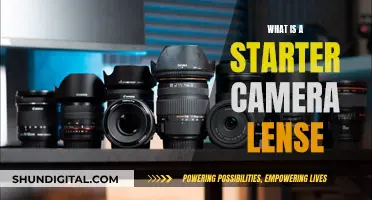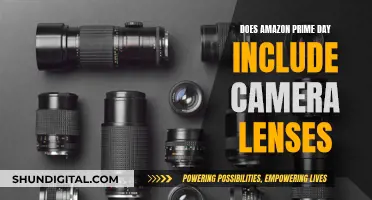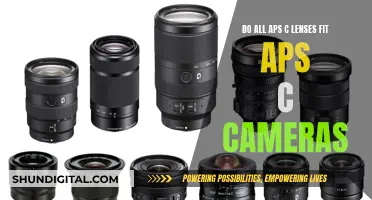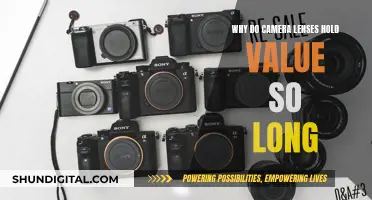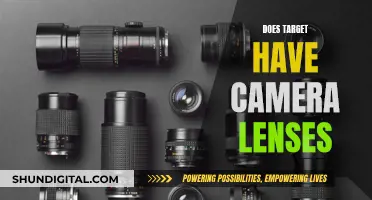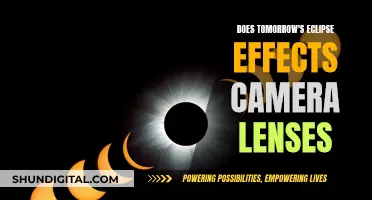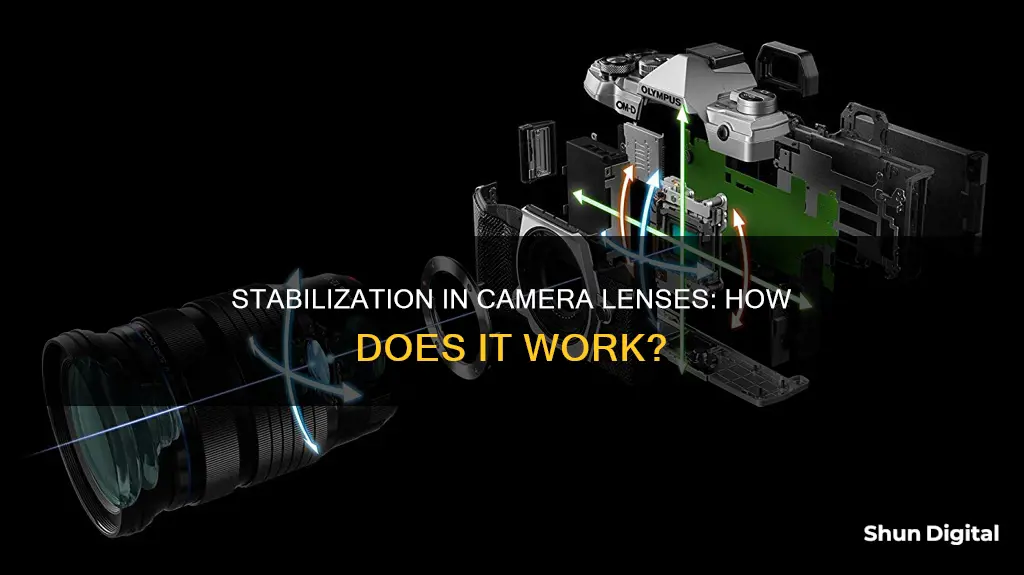
Camera lenses can be stabilized in two ways: through lens stabilization or in-body image stabilization (IBIS). Lens stabilization works by moving the glass elements within the lens to counteract camera movement, while IBIS moves the sensor along various axes to compensate for camera shake. Both technologies enable photographers to capture sharp images in low-light conditions or with longer lenses, which would otherwise require a tripod. The effectiveness of lens stabilization varies, but modern lenses often offer approximately 4-6 stops of image stabilization, allowing for slower shutter speeds without sacrificing image quality.
| Characteristics | Values |
|---|---|
| Number of ways cameras can stabilize themselves | 2 |
| Types of stabilization | Lens stabilization, In-body image stabilization (IBIS) |
| Lens stabilization mechanism | Moving the glass elements within the lens to counteract camera movement |
| Lens stabilization other names | Vibration Reduction (VR), Optical Image Stabilization (O.I.S), Optical SteadyShot Image Stabilization (O.S.S), Image Stabilization (IS), POWER Optical Image Stabilizer |
| IBIS mechanism | Moving the sensor along various axes to compensate for camera movement |
| IBIS effectiveness | 5 stops of image stabilization |
| IBIS in modern mirrorless cameras | All Nikon and Sony full-frame mirrorless cameras have IBIS |
| IBIS in Canon cameras | Canon R8 does not have IBIS |
| IBIS in Pentax DSLRs | All Pentax DSLRs have IBIS |
| IBIS in Nikon DSLRs | Nikon DSLRs do not have IBIS |
| IBIS in Canon DSLRs | Some Canon cameras do not have IBIS |
What You'll Learn

Lens-based vs in-camera stabilization
There are two types of image stabilization: lens-based and in-camera. Lens-based stabilization uses a floating lens element, which is electronically controlled and shifted opposite to any camera shake recorded by the camera. In-camera stabilization, also known as IBIS (in-body image stabilization), works similarly but will physically shift the image sensor to compensate for these movements.
Lens-based stabilization
Lens-based stabilization has several advantages. It offers smoother performance when using longer focal length lenses. It also provides a calm view through the viewfinder without much shakiness. This is especially useful for DSLRs that do not have any stabilization built-in.
However, lens-based stabilization has its downsides. It is not available as an option for all lenses, and it adds to the cost of the lens.
In-camera stabilization
In-camera stabilization has its own benefits. You gain the advantages of IS technology with any lens you can mount on the camera for considerably less cost than multiple IS-enabled optics. IBIS also means that shorter focal length-lens designs can be simpler and potentially lighter, since the lens stabilization gadgetry does not need to be incorporated into the lens.
The downside of in-camera stabilization is that it’s less effective at smoothing the bumps when shooting with longer focal length optics when compared to lens-based stabilization.
Camera Contact Lenses: Fact or Fiction?
You may want to see also

Image stabilization technology
Image stabilization (IS) is a technology that helps photographers take sharp images in lighting conditions that would otherwise be too poor to capture a clear shot. It does this by reducing blurring caused by the movement of a camera during exposure. This is particularly useful in low-light settings, or when using a long focal length lens (telephoto or zoom).
There are two types of image stabilization: lens-based and in-camera. Lens-based stabilization uses a floating lens element, which is electronically controlled and shifted in the opposite direction to any camera shake that is recorded. In-camera systems, or in-body image stabilization (IBIS), work similarly, but will physically shift the image sensor to compensate for these movements.
Lens-based stabilization smooths performance when using longer focal length lenses. The downside is that it's not available as an option for all lenses and it adds to the cost. In-camera stabilization, on the other hand, is effective with any lens you can mount on the camera, and is therefore a more affordable option. However, it is less effective when using longer focal length optics.
Optical image stabilization (OIS) is a mechanism used in still or video cameras that stabilizes the recorded image by varying the optical path to the sensor. This technology is implemented in the lens itself, as distinct from in-body image stabilization (IBIS), which operates by moving the sensor. The key element of all optical stabilization systems is that they stabilize the image projected on the sensor before the sensor converts the image into digital information. IBIS can have up to 5 axes of movement: X, Y, Roll, Yaw, and Pitch.
Different companies have different names for the OIS technology, for example: Vibration Reduction (VR) (Nikon), Image Stabilizer (IS) (Canon), Anti-Shake (AS) (Minolta and Konica Minolta), Optical SteadyShot (OSS) (Sony), and Vibration Compensation (VC) (Tamron).
In-body image stabilization requires the lens to have a larger output image circle because the sensor is moved during exposure and thus uses a larger part of the image. Compared to lens movements in optical image stabilization systems, the sensor movements are quite large, so the effectiveness is limited by the maximum range of sensor movement.
Digital image stabilization (DIS), or electronic image stabilization (EIS), is used in some video cameras. This technique shifts the cropped area read out from the image sensor for each frame to counteract the motion. This requires the resolution of the image sensor to exceed the resolution of the recorded video, and it slightly reduces the field of view because the area on the image sensor outside the visible frame acts as a buffer against hand movements.
Lenses Unlocked: Capturing Unique Perspectives and Effects
You may want to see also

When to use stabilization
Image stabilization is a technology that helps photographers capture sharp images in low-light conditions and when using longer focal length lenses. It is particularly useful when you cannot use a tripod. There are two types of image stabilization: lens-based and in-camera. Lens-based stabilization uses a floating lens element to counteract camera shake, while in-camera stabilization physically shifts the image sensor.
- Low-Light Conditions: Image stabilization allows you to capture sharp images in low-light conditions by enabling you to use slower shutter speeds without introducing blur from camera shake. This is especially useful when you don't have a tripod or need to shoot handheld.
- Longer Focal Length Lenses: When using longer focal length lenses, such as telephoto lenses, even a small shake of the camera can result in significant movement at the pivot point. Image stabilization, especially lens-based stabilization, helps compensate for this movement and results in sharper images.
- Handheld Photography: If you are shooting handheld, image stabilization can be a lifesaver. It allows you to use slower shutter speeds while maintaining sharp focus. This is particularly useful when you are unable to use a tripod or need the flexibility of handheld shooting.
- Static Subjects: Image stabilization is ideal for capturing sharp images of static or still subjects. It is important to note that it will not help freeze fast-moving objects, but it will allow you to use slower shutter speeds to capture more light and detail in static scenes.
- Smoother Performance: Lens-based stabilization often provides smoother performance when using longer focal length lenses. This can be beneficial for certain types of photography, such as wildlife or sports photography, where you need to quickly adjust your framing without introducing blur.
- Video Recording: While image stabilization can be beneficial for video recording, it is important to note that some systems may introduce subtle movements that can make your footage appear jerky. Test your setup to determine if stabilization improves your video quality.
Remember, image stabilization is not always necessary, and there are times when you should turn it off. For example, when using a tripod, shooting with very fast shutter speeds, or capturing fast-moving subjects, you may achieve better results with stabilization turned off. Additionally, image stabilization can drain your battery faster, so consider turning it off when it's not needed.
Camera Lenses in China: Cheaper or Expensive?
You may want to see also

Effectiveness of stabilization
The effectiveness of stabilization in camera lenses varies depending on the type of stabilization used, the camera, and the lens. There are two types of stabilization: lens-based stabilization and in-camera stabilization.
Lens-based stabilization, also known as in-lens stabilization, optical stabilization, or lens stabilization, works by moving the glass elements within the lens to counteract camera movement. It uses sensors to detect how the camera is moving and adjusts the lens elements accordingly. This type of stabilization is generally more effective for longer focal lengths and in low-light conditions. It also provides a more stable view through the viewfinder, which can be helpful when using DSLRs that do not have any stabilization built-in. Most modern lenses with lens-based stabilization offer approximately 4-6 stops of image stabilization, allowing photographers to use slower shutter speeds while still achieving sharp images.
On the other hand, in-camera stabilization, also known as in-body image stabilization (IBIS), works by moving the sensor within the camera body to compensate for camera movement. IBIS is universal and works with all lenses, making it a more cost-effective option in the long run. It also has the advantage of being silent, as there are no additional noises from the lens while focusing. Additionally, IBIS offers cleaner bokeh when engaged, as the optics remain stationary. However, one of the main disadvantages of IBIS is that it is less effective with longer focal lengths. While IBIS typically provides around 5 stops of image stabilization, this may be reduced to only 1-2 stops when using a long lens of 400mm or more.
Both types of stabilization have their strengths and weaknesses, and in some cases, they can be used together for even better results. The effectiveness of stabilization will also depend on the specific camera and lens being used, as different manufacturers implement these technologies in slightly different ways. Ultimately, the decision to use lens-based or in-camera stabilization, or a combination of both, will depend on the photographer's specific needs and preferences.
Lens Identification: Serial Numbers on Camera Lenses
You may want to see also

Stabilization for video
Video stabilization is a crucial technique for achieving smooth and watchable footage, especially when filming handheld or in unstable conditions. There are various methods and tools available to stabilize videos, ranging from in-camera and lens-based stabilization systems to post-production software and online tools. Here's an overview of the different stabilization techniques and their benefits for video:
In-Camera Stabilization (IBIS)
In-body image stabilization, or IBIS, is a feature found in some camera bodies. It works by moving the sensor along various axes to compensate for camera movement. IBIS is advantageous because it works with any lens mounted on the camera. This means that even older manual lenses or lenses without built-in stabilization can benefit from IBIS. Additionally, IBIS allows for simpler and potentially lighter lens designs since the stabilization mechanism is incorporated into the camera body rather than the lens.
IBIS is generally quite effective, offering around 5 stops of image stabilization, and in some cases, up to 8 stops. However, one of its limitations is that it is less effective with longer focal length lenses. When using very long lenses (400mm or more), the stabilization may be less noticeable, and you might only experience 1-2 stops of stabilization.
Lens-Based Stabilization
Lens-based stabilization, also known as optical stabilization, involves moving the glass elements within the lens to counteract camera movement. Lenses with this technology use sensors to detect the camera's motion and adjust their elements accordingly. One of the benefits of lens-based stabilization is smoother performance when using longer focal length lenses. This type of stabilization is often found in DSLR cameras and is very effective for stabilizing the viewfinder image, making it easier to compose your shots.
However, lens-based stabilization has some drawbacks. It is usually more expensive, and not all lenses offer this feature. Additionally, it can add complexity to the lens design and increase the weight of the lens.
Post-Production Software Stabilization
Even with stabilization technology in your camera or lens, you may still need to do some post-production work to smooth out shaky footage. Software like Adobe Premiere Pro offers powerful stabilization tools, such as the Warp Stabilizer effect, which can remove unwanted camera shake with just a few clicks. This allows you to fine-tune your footage and get the exact look and feel you desire.
Online Video Stabilization Tools
There are also several online tools available that can help stabilize shaky videos. These tools, such as CapCut, DaVinci Resolve, and HitFilm Express, often use advanced algorithms and artificial intelligence to stabilize your footage automatically. They are usually easy to use, requiring just a few clicks or drag-and-drop actions to upload and stabilize your videos. These tools can be a quick and convenient way to improve the stability and smoothness of your footage without the need for expensive software or specialized hardware.
In conclusion, stabilization is an essential aspect of video production, ensuring smooth and watchable footage. By understanding the different stabilization techniques and tools available, you can make informed decisions about which methods work best for your specific needs and equipment setup.
Understanding Camera Lens Interchangeability: What You Need to Know
You may want to see also
Frequently asked questions
Camera stabilisation, or image stabilisation, is a technology that helps photographers take pictures in low-light conditions that would otherwise result in blurry images.
There are two types of image stabilisation: lens-based and in-camera. Lens-based stabilisation uses a floating lens element that is electronically controlled and shifted opposite to any camera shake recorded by the camera. In-camera systems work similarly, but will physically shift the image sensor to compensate for these movements.
Camera stabilisation is particularly useful for shooting with longer focal length lenses, in low-light conditions, or when shooting handheld.
Camera stabilisation is not necessary, but it can be a useful tool to have, especially if you are shooting in low-light conditions or with longer focal length lenses.


